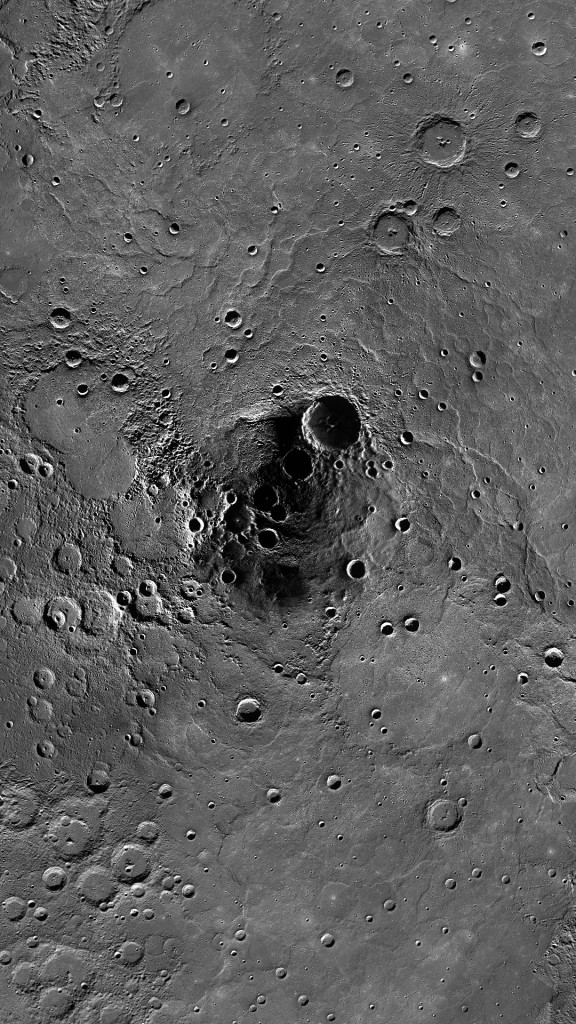Science
Related: About this forumMercury’s Shadowy North Pole

Many MDIS images were averaged together to create a mosaic of Mercury’s polar region, which this stereographic projection is centered on.
The largest centrally-peaked crater near the center is Prokofiev, named after a 20th-century Russian composer. Approximately 110 km (68 mi.) in diameter, its permanently-shadowed interior is home to radar-bright deposits that are thought to contain water ice.
Even though Mercury is almost three times closer to the Sun than Earth is and hosts searing daytime temperatures of 425ºC (800ºF), there’s virtually no atmosphere to hold or transmit that heat. Nighttime temperatures can reach as low as -185ºC (-300ºF), and since a day on Mercury is 176 Earth days long it gets very cold for quite a long time!
Also, because Mercury’s axis of rotation isn’t tilted like Earth’s, low elevation areas near the poles receive literally no sunlight. Unless vaporized by a meteorite impact any ice gathered inside these deep craters would remain permanently frozen.
Read more: http://www.universetoday.com/98651/mercurys-north-pole/
krispos42
(49,445 posts)...about a spaceship going to the coldest spot in the Solar System... the dark side of Mercury.
This was when it was believed that Mercury was tidally locked to the Sun.
So we could build an outpost at one of Mercury's poles in the permanent shadow of a crater wall, then arrange mirrors to point just enough sunlight at the colony to make it warm and comfy and well-lit!
1620rock
(2,218 posts)...if you are talking a maned spacecraft. Not only is it hot, but their is probably a ton of solar radiation too.
Thor_MN
(11,843 posts)Just enough shadow, just enough sunlight..
Art_from_Ark
(27,247 posts)I have always been interested in space exploration, ever since the days of the Gemini and Apollo missions. Thanks for posting this ![]()
However, I think a correction is in order in the original article-- a day on Mercury is about 58 earth days, meaning that there is the equivalent of 29+ Earth days of uninterrupted sunshine and then 29+ Earth days of uninterrupted darkness.
muriel_volestrangler
(101,385 posts)ie the time for a star (effectively at infinite distance) to come back to the same position in the sky. But since Mercury's orbit period is 88 days, it takes longer than either for the Sun to get back to the same position in the sky, ie midday to midday - by the time Mercury has rotated once, relative to the stars, it's gone 2/3rds through its orbit, so it would have to rotate another 2/3rds to get the Sun in a similar position, ie another 39 days, and then a bit more to make up for how much further it went in that orbit, etc. The end result is the solar day is 176 days long. And for the purposes of the heating from the Sun, that's the day we're interested in.
Here's the NASA figures:
--------------------------- Mercury Earth -- Ratio (Mercury/Earth)
- Sidereal orbit period (days) 87.969 365.256 0.241
Sidereal rotation period (hrs) 1407.6 23.9345 58.785
------- Length of day (hrs) 4222.6 24.0000 175.942
reACTIONary
(5,788 posts)... from the surface of Mercury, the sun rises, progress higher in the sky, then goes BACKWARD back toward the sun rise point, then FORWARD again, higher in the sky and on down the other side for sunset.
muriel_volestrangler
(101,385 posts)because the orbit is very eccentric, Mercury's angular velocity around the Sun is more, for a short time, than its rotational angular velocity, so the Sun would appears to go backwards. The Wikipedia explanation:
http://en.wikipedia.org/wiki/Mercury_%28planet%29
reACTIONary
(5,788 posts)gtar100
(4,192 posts)then at some point in the morning and evening it is a pleasant 72 degrees. Now if we could just hover around in one of those regions, we'd be all right (bring your own oxygen, of course). ![]()